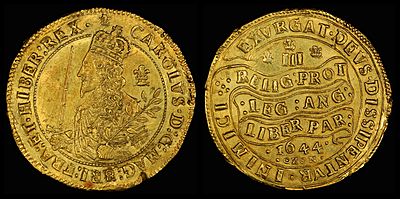Triple Unite (English coin) facts for kids
The Triple Unite was a very special gold coin made in England a long time ago. It was worth a lot of money, about three pounds, or sixty shillings! This coin was the largest gold coin ever made in England using an old method called "hammered coinage." This means coins were made by hand, by hitting metal with a hammer.
The Triple Unite was only made during a big conflict in England called the English Civil War. This was a time when King Charles I and his supporters were fighting against Parliament. The king's mints, where coins were made, produced these coins in Oxford (from 1642 to 1644) and, very rarely, in Shrewsbury in 1642. Each Triple Unite coin weighed about 27.3 grams.
What Do These Coins Look Like?
These gold coins are truly beautiful. They often show King Charles I holding a sword and an olive branch. The sword represents his power, but the olive branch shows he wanted peace, not war.
The Rare Shrewsbury Coin
The coins made in Shrewsbury are extremely rare. On the front side of the coin (called the obverse), you can see a plume (a feather decoration) behind the king's head. Around the edge, there's a Latin phrase that means "Charles by the grace of God King of Great Britain France and Ireland."
On the back side of the coin (called the reverse), there's another important Latin phrase written in three lines. It means "The religion of the Protestants, the laws of England and the liberty of Parliament." Above this message, there are three plumes and the Roman numeral III, which shows the coin's value (three pounds). Below the message, it says "1642" for the year it was made. Around the whole design, another Latin phrase means "Let God arise and His enemies be scattered." This phrase comes from a Bible verse.
The Oxford Coins
The Triple Unites made in Oxford are quite similar to the Shrewsbury ones. The main difference is that the Latin phrase on the back of the Oxford coins is also in three lines, but the phrase around the king's head on the front is slightly shorter. Oxford coins were made in 1642, 1643, and 1644, and each year had small changes in their design.


